Just outside Chet Kokkeler’s office sits the fleet of trucks, equipment, trailers, and vehicles needed for running a successful landscaping business. All the vehicles are well-maintained and constantly on the move.
At the front of the line is Chet’s ’15 GMC Denali 2500HD, the rig he uses to do everything from meeting with clients to moving equipment to jobsites to towing the family play toys on the weekends. Chet is the type of truck owner who places functionality and reliability at the very top of his priority list, which means he chooses upgrades—like having his ride’s suspension lifted so 35-inch mud tires will fit—very carefully. However, the downside of using taller rubber is that the truck doesn’t perform like it did with the stock setup, because the effective final-drive ratio is changed, as is the rolling mass.
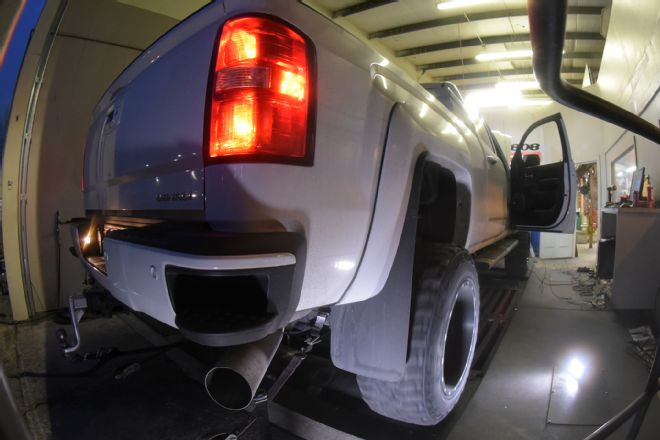
| 008 Hypertech Dyno Action
White-Glove Hot-Rodding
There are plenty of upgrades available to boost the power of GM’s workhorse 6.6L Duramax engine, which puts out 397 hp at 3,000 rpm and 765 lb-ft of torque at 1,600 rpm. But, like many other truck-owning businessmen, Chet isn’t keen on making physical changes to the engine or messing with the emissions system on a brand-new pickup. On the other hand, giving the engine a reliable, 50-state-legal tune is quite acceptable.
Hypertech’s Max Energy 2.0 programmer does just that. This smartphone-sized tuner is easy to use and doesn’t require any modifications to the truck—inside or out. You simply plug the cable from the palm-size device into the truck’s OBDII port under the dash and follow the commands as they pop up on the programmer’s screen.
Along the way, you have the option of selecting one of four levels of engine performance: Stock; Stage 1; Stage 2; and Stage 3. In the highest level, Hypertech’s published Superflow chassis dyno report shows a maximum performance increase of 40 hp and 63 lb-ft of torque at 3,300 rpm.
Behind each selection, there’s a lot going on electronically in the Max Energy 2.0, as we found out when talking with Hypertech’s chief engineer and software programmer, John Lambert. John says the unit does its magic in a number of ways to bring more power to the wheels while remaining 50-state smog legal and keeping the 6.6L LML’s durability unaffected even while towing at max loads.
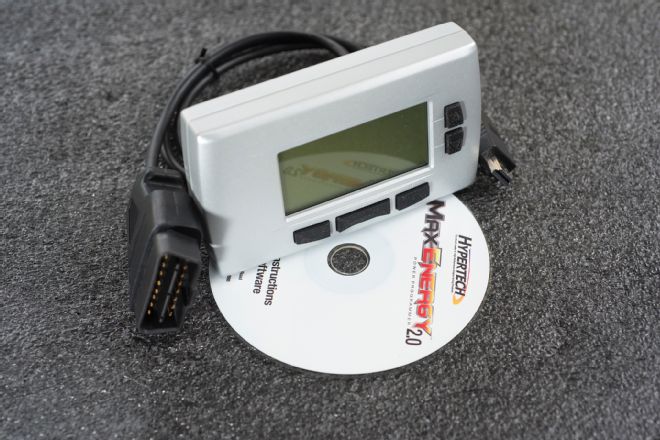
| 002 Hypertech2 Programmer
The palm-sized Hypertech Max Energy 2.0 programmer is simple to use and comes with a dongle for connecting the programmer to the truck’s OBDII port. Once the unit’s operating software is uploaded into a laptop, the data for a specific engine is then downloaded from Hypertech’s server into the programmer, making it ready to interface with the truck’s ECM.
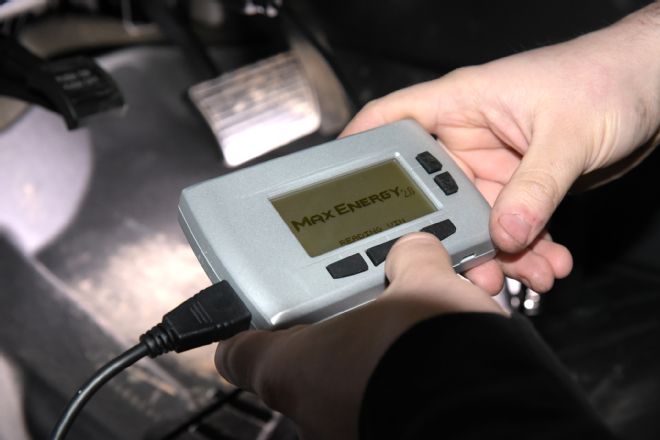
| 003 Hypertech Reading VIN
GM introduced a new ECM for the Duramax LML engine that includes calibration that can’t be processed immediately by plug-in programmers. Once the Max Energy 2.0 is connected to the vehicle (through the OBDII port), it uses the VIN to identify and download the stock calibrations. When the programmer imports the factory tunes, the user must then update the unit by obtaining the latest tuning from Hypertech’s website.

| 004A Hypertech GMC BWS 9254
Once the programmer gathers the vehicle data, it must be connected to Hypertech’s mainframe online in order to download the tunes that will be flashed into the truck’s computer. Be patient. This process, with its numerous checks and double-checks, takes at least 10 minutes and may even require a second “update,” as ours did.
Fine Tuning
“Tuning diesel engines is all about fuel,” John says. “These engines always operate in an excess air mode (i.e. lean of stoichiometric air/fuel ratios), so making power is just a matter of adding fuel. It sounds as simple as that on the surface, anyway. The computer controls on the fueling are actually quite complicated and require a lot of experimentation to perfect the fueling delivery.”
Hypertech’s engineers spend hundreds of hours making pulls, dissecting the results, making incremental adjustments to the injector pulse widths, and watching how those changes affect the engine’s power curve on the dyno. A longer pulse width equals more fuel.
John says the Hypertech tuning team also pays very close attention to brake-specific fuel consumption (BSFC), fuel-to-power ratio, turbo inlet/outlet temperatures, and EGT during the development of a tune.
At some point in the long development process, every diesel calibration reaches either a “point of diminishing return (the amount of fuel needed to get the power),” or EGT climbing to a point that will endanger engine reliability and longevity. When either of those thresholds is reached, the engineers de-tune a little and head to the open road for the next phase of tuning/testing.
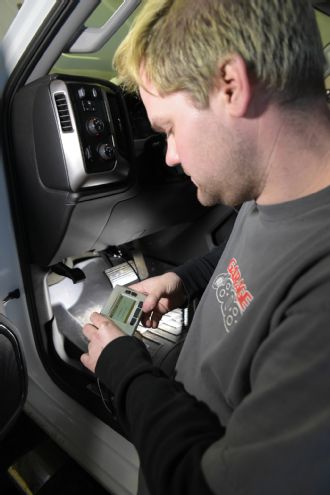
| 005 Uploading The Tune
Tim Walton, Garage 808’s dyno engineer and tuning expert, breezed through the Hypertech Max Engergy 2.0’s four different tuning stages (Stock, Stage 1, Stage 2, and Stage 3) during the dyno runs. Uploading each tune requires turning the ignition key to the “On” or “Off” positions during the process.
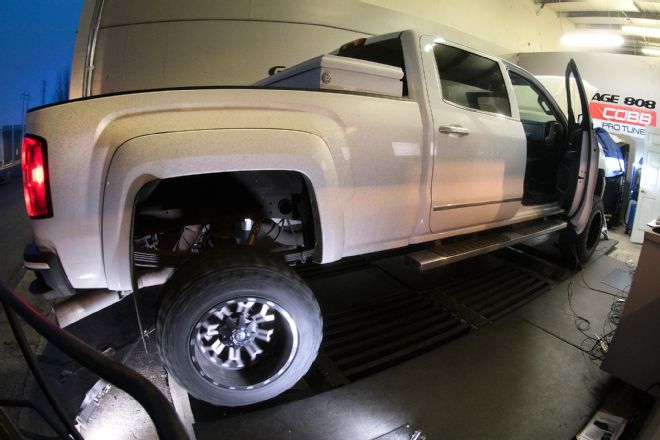
| 006 Garage 808 Dyno Room
It’s a tight fit for the big GMC Sierra 2500HD Denali on Garage 808’s Dynojet 424xLC1 all-wheel-drive dyno. The dyno room is usually running tricked-out Subarus and Hondas, but it handles big diesels just fine.
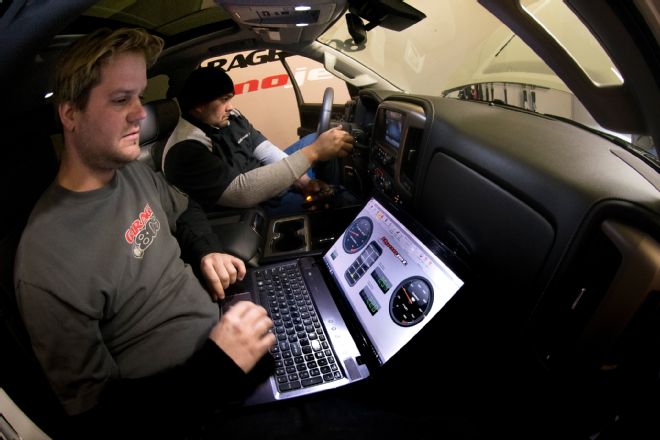
| 007 Hypertech GMC Testing
Tim uses a wireless system to monitor and adjust the dyno’s testing software, while Garage 808’s owner, James McCoy, serves as the testdriver. Four runs are made with every calibration, allowing cooldowns while each new tune was loaded into the ECM.
In the Real World
Hypertech engineers spent a considerable amount of time perfecting the tune for the latest-generation 6.6L Duramax LML engine.
“Real-world testing is one of the most laborious tasks in the development of diesel calibrations,” John says. “Since most vehicles rarely see wide-open throttle during normal duty in the real world, we ensure Hypertech's tuning improvements are noticeable all the time, rather than just the occasional full-throttle pull.”
One area the Max Energy 2.0 tune leaves relatively untouched is turbocharger boost. Why? “Along with fueling there is also boost control,” John says. “But it has become very rare in the past few generations of Duramax diesels that the turbos have room for notable increases in boost before becoming inefficient. GM does a great job sizing the turbochargers for the power output they provide.”
Testing Our Own
We took Chet’s truck and the Hypertech Max Energy 2.0 programmer to Garage 808 in Eugene, Oregon, to have dyno technician Tim Walton test each stage of the programmer—from Stock to Stage 3 using a Dynojet 424xLC1 chassis dyno to evaluate all-so-critical rear-wheel horsepower. Tim ran the ¾-ton GMC’s Allison six-speed automatic transmission in Fifth gear with no load in order to achieve repeatable results.
Testing in Fifth gear eliminates any downshifting issues during the pulls. However, the side effect of using Fifth is the truck’s 102-mph speed limiter, which prevents running the engine to its red line. Still, our dyno results are relatively close to Hypertech’s data, with Stage 3 showing an 8- to 11-percent gain in torque compared to stock from 1,900 rpm to 2,800 rpm (where the speed limiter cut in).
Our dyno tests show Stage 1 bumps peak horsepower by 12.3 hp and 24.1 lb-ft of torque, while Stage 2 increases power by 24.5 hp and 38.1 lb-ft torque. Stage 3 provides a slightly bigger power jump, helping the 6.6L LML gain 45.1 hp and 68.3 lb-ft in torque.
Max boost during the baseline dyno runs stayed around 26.8 pounds, while the pressure created with Hypertech tunes varied slightly from 27.2 psi (Stage 1) to 27.9 psi with Stage 3.
“Stage 1 and Stage 2 power levels offer our customers a detuned version of our Stage 3 tuning to suit their desired power increase and still provide this power under any towing condition that does not exceed the rating of the vehicle,” John says. We offer alternate power levels to allow users to choose the power level they want to drive.”
Out on the open road, the power gains of the Max Energy 2.0’s Stages 1 and 2 are barely noticeable. However, Chet says Stage 3 brings his ’15 GMC Denali’s performance back to where it was prior to having the lift kit and 35s installed. “I notice the power improvement from Stage 3 more while towing than I do running empty. It’s nice to get the performance back,” he says.
Although we haven’t had enough time to determine actual fuel-economy improvements, other customers report seeing as much 2-mpg gains during highway driving. If that holds true for Chet’s Denali, then it’s a bonus for those who like to see a return on the investment that goes beyond adding more towing muscle.
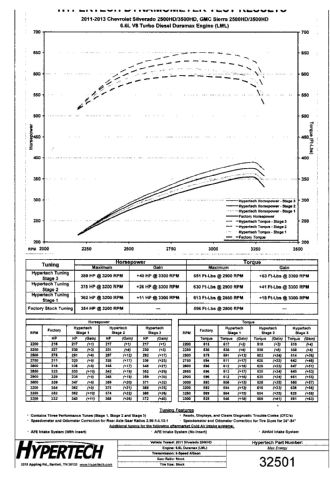
| Hypertech Dyno Chart LML
Stage 1, 2, and 3 tunes are a combination of engine and transmission tuning together, so there’s no adjustments that can be made by the end user. But, the unit’s Quick Commands menu facilitates adjusting the front, rear, or both tire-warning thresholds from 25 psi up to 95 psi to accommodate bigger tires like the 35s on this truck. You can also adjust the speedometer for different tire sizes and clear codes among other tuning options.
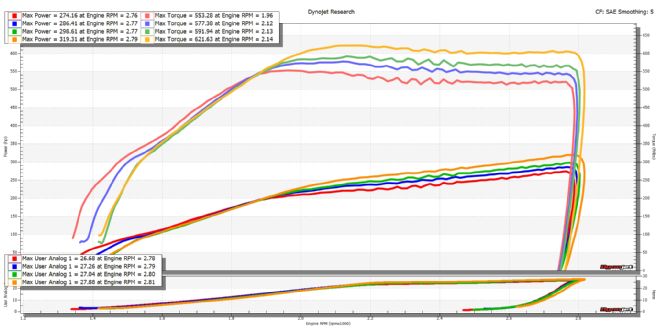
| 009 Duramax Max Values
More to Come
This story doesn’t end here. Along with a mild tune, Chet wants to further improve his GMC’s performance with the addition of a cold-air intake system and a DPF-back exhaust. He’s in luck. A hidden aspect of the Hypertech Max Energy 2.0 programmer is those mods have been taken into consideration during the tune’s development process.
Cold-air intakes change the air velocity and the volume of air passing over the mass airflow (MAF) sensor due to the shape and size of the ducting around the MAF sensor and even the type of air filter used. It’s not uncommon for some Duramax aftermarket filters and cold-air intakes to trip P0101 codes because they create vortices in the intake tube that cause the MAF sensor to signal the engine control module (ECM)) that there’s an airflow problem, putting the Duramax into limp mode.
Hypertech has taken those potential MAF issues into consideration by putting several popular cold-air intake systems on its test mule and tuning the programmer accordingly.
“Retuning the engine calibration for specific popular cold-air intakes that are installed is necessary to correct the MAF readings and to take advantage of the increased airflow,” John explains. When an aftermarket cold-air intake is installed, you can go into the Max Energy 2.0, select the one you have, and the programmer makes the appropriate adjustments to the Hypertech tune selected.
With that in mind, we will also be installing a cold-air intake system and DPF-back exhaust on Chet’s Denali. When we do, we’ll roll back onto Garage 808’s chassis dyno to see how better breathing and the Hypertech Max Energy 2.0 programmer further help the 6.6L Duramax LML build more power.
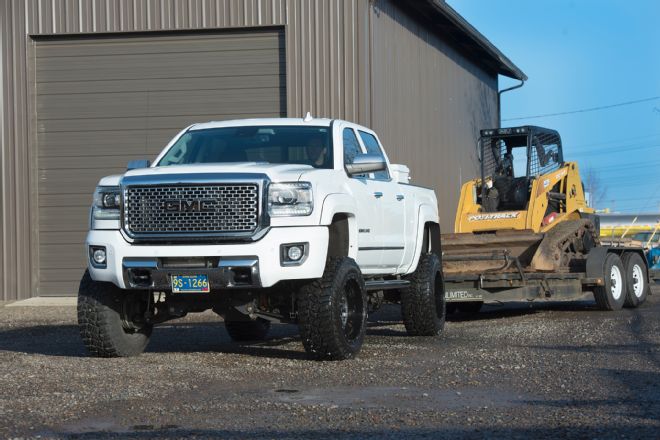
| 001 GMC Duramax Hypertech Lead3
 | 008 Hypertech Dyno Action
White-Glove Hot-Rodding
| 008 Hypertech Dyno Action
White-Glove Hot-Rodding | 002 Hypertech2 Programmer
The palm-sized Hypertech Max Energy 2.0 programmer is simple to use and comes with a dongle for connecting the programmer to the truck’s OBDII port. Once the unit’s operating software is uploaded into a laptop, the data for a specific engine is then downloaded from Hypertech’s server into the programmer, making it ready to interface with the truck’s ECM.
| 002 Hypertech2 Programmer
The palm-sized Hypertech Max Energy 2.0 programmer is simple to use and comes with a dongle for connecting the programmer to the truck’s OBDII port. Once the unit’s operating software is uploaded into a laptop, the data for a specific engine is then downloaded from Hypertech’s server into the programmer, making it ready to interface with the truck’s ECM.
 | 003 Hypertech Reading VIN
GM introduced a new ECM for the Duramax LML engine that includes calibration that can’t be processed immediately by plug-in programmers. Once the Max Energy 2.0 is connected to the vehicle (through the OBDII port), it uses the VIN to identify and download the stock calibrations. When the programmer imports the factory tunes, the user must then update the unit by obtaining the latest tuning from Hypertech’s website.
| 003 Hypertech Reading VIN
GM introduced a new ECM for the Duramax LML engine that includes calibration that can’t be processed immediately by plug-in programmers. Once the Max Energy 2.0 is connected to the vehicle (through the OBDII port), it uses the VIN to identify and download the stock calibrations. When the programmer imports the factory tunes, the user must then update the unit by obtaining the latest tuning from Hypertech’s website.
 | 004A Hypertech GMC BWS 9254
Once the programmer gathers the vehicle data, it must be connected to Hypertech’s mainframe online in order to download the tunes that will be flashed into the truck’s computer. Be patient. This process, with its numerous checks and double-checks, takes at least 10 minutes and may even require a second “update,” as ours did.
| 004A Hypertech GMC BWS 9254
Once the programmer gathers the vehicle data, it must be connected to Hypertech’s mainframe online in order to download the tunes that will be flashed into the truck’s computer. Be patient. This process, with its numerous checks and double-checks, takes at least 10 minutes and may even require a second “update,” as ours did.
 | 005 Uploading The Tune
Tim Walton, Garage 808’s dyno engineer and tuning expert, breezed through the Hypertech Max Engergy 2.0’s four different tuning stages (Stock, Stage 1, Stage 2, and Stage 3) during the dyno runs. Uploading each tune requires turning the ignition key to the “On” or “Off” positions during the process.
| 005 Uploading The Tune
Tim Walton, Garage 808’s dyno engineer and tuning expert, breezed through the Hypertech Max Engergy 2.0’s four different tuning stages (Stock, Stage 1, Stage 2, and Stage 3) during the dyno runs. Uploading each tune requires turning the ignition key to the “On” or “Off” positions during the process.
 | 006 Garage 808 Dyno Room
It’s a tight fit for the big GMC Sierra 2500HD Denali on Garage 808’s Dynojet 424xLC1 all-wheel-drive dyno. The dyno room is usually running tricked-out Subarus and Hondas, but it handles big diesels just fine.
| 006 Garage 808 Dyno Room
It’s a tight fit for the big GMC Sierra 2500HD Denali on Garage 808’s Dynojet 424xLC1 all-wheel-drive dyno. The dyno room is usually running tricked-out Subarus and Hondas, but it handles big diesels just fine.
 | 007 Hypertech GMC Testing
Tim uses a wireless system to monitor and adjust the dyno’s testing software, while Garage 808’s owner, James McCoy, serves as the testdriver. Four runs are made with every calibration, allowing cooldowns while each new tune was loaded into the ECM.
| 007 Hypertech GMC Testing
Tim uses a wireless system to monitor and adjust the dyno’s testing software, while Garage 808’s owner, James McCoy, serves as the testdriver. Four runs are made with every calibration, allowing cooldowns while each new tune was loaded into the ECM.
 | Hypertech Dyno Chart LML
Stage 1, 2, and 3 tunes are a combination of engine and transmission tuning together, so there’s no adjustments that can be made by the end user. But, the unit’s Quick Commands menu facilitates adjusting the front, rear, or both tire-warning thresholds from 25 psi up to 95 psi to accommodate bigger tires like the 35s on this truck. You can also adjust the speedometer for different tire sizes and clear codes among other tuning options.
| Hypertech Dyno Chart LML
Stage 1, 2, and 3 tunes are a combination of engine and transmission tuning together, so there’s no adjustments that can be made by the end user. But, the unit’s Quick Commands menu facilitates adjusting the front, rear, or both tire-warning thresholds from 25 psi up to 95 psi to accommodate bigger tires like the 35s on this truck. You can also adjust the speedometer for different tire sizes and clear codes among other tuning options.
 | 009 Duramax Max Values
| 009 Duramax Max Values
 | 001 GMC Duramax Hypertech Lead3
| 001 GMC Duramax Hypertech Lead3